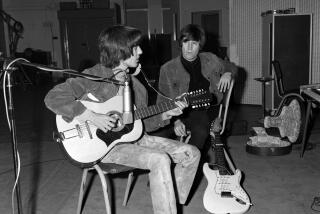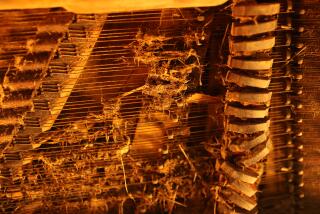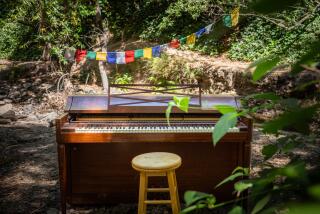500,000th Piano Debuts at Carnegie Hall : Making of a Steinway Takes a Lot of Practice
NEW YORK â In a box-shaped, soundproof room, Raymond Parada stands before a piano keyboard pulled from its shining 9-foot body. Parada plinks at the keys, listening carefully, making adjustments instinctively.
No music pours from the instrument. Parada is not a pianist. Instead, he âturns music boxes into Steinways,â spending 24 hours with the inner workings of each piano, creating concert grands for artists from Vladimir Horowitz to Billy Taylor.
âThe piano must allow an artist to develop his talents. It is not like an automobile, where it works the same for everybody--you turn the wheel right, the automobile goes right,â explains Parada, who does things the old-fashioned way at Steinway & Sons.
Fussed and Fawned Over
In fact, everythingâs done much the same way it has been done since John Engelhard Steinway arrived from Germany in 1853 and switched from cabinetmaking to keyboards. The Steinway piano is still hand-strung, fussed and fawned over, individually numbered, tuned and retuned by highly skilled specialists like Parada.
It still takes one full year to create the Steinway concert grand, âthe piano by which all others are judged,â the product of more than 100 patented piano-making techniques.
It remains the choice of the great pianists--Claudio Arrau, Van Cliburn, Horowitz--as it was the choice of Ignace Paderewski and Franz Liszt a century ago.
âItâs the only piano for me,â says Peter Nero. âI was 13 when I started in competition at the Brooklyn Academy of Music, 14 when I started at Juilliard and itâs been Steinway all the way.â
The 500,000th Steinway, designed by artist Wendell Castle, was unveiled Thursday at a Carnegie Hall concert. Yamaha, its top competitor, reaches the 500,000 mark every 2 1/2 years on its assembly line in Japan.
Doesnât Come Cheap
The Steinway doesnât come cheap either:The price list runs from $7,500 to $40,000 for the 9-foot concert grand (though the 500,000th Steinway has an estimated value of $500,000). Yamahaâs least expensive piano costs about $2,700, but its concert grand prices are about the same as Steinway.
How has Steinway survived 135 years, outlasting an assortment of competitors while keeping its reputation for quality?
âA Steinway is a Steinway only because we donât cut any corners,â says John Steinway, 70, one of the last two family members still in the piano-making business. âWe make quality, nothing but the top quality we can make.
âMy great-grandfather started that when he started the firm 135 years ago. I often say weâre probably thickheaded and stubborn. We stick to our principles. But it works.â
âThe Steinway manufacturing process relies on tradition,â offers William Garlick, an antique piano aficionado now employed as Steinwayâs national field service manager. âThat tradition has carried on, although we donât ignore technology.â
Instead, an exacting process that combines the innovative and the antiquated is used to create 3,400 Steinway pianos each year at the companyâs 11-acre Queens factory.
Hand-Trims Veneer
In one part of the plant, a worker hand-trims pieces of veneer for the pianoâs outer surface with a 120-year-old machine. Later in the process, a newly developed machine perfectly shapes its soundboard to fit the piano body.
âEven that is not a production-line concept,â says Bruce Stevens, president of the firm since Steinway Musical Properties Inc., bought it three years ago. âItâs letting technology do something even better than we could do it before. One man still handles that job alone.â
There are many answers as to what makes a Steinway a Steinway:the input of the artists, the commitment to quality, the genius of 19th-Century piano meister C. F. Theodore Steinway. But those responses may miss the forest for the trees, which provide the Steinway wood.
âOne of the things done right here is we use only good wood,â Garlick says. âWe have people constantly looking throughout the world for good wood.â
The wood--imported mahogany, northeast rock maple, yellow poplar--is improved through aging. Air-dried outdoors for up to 18 months, the wood is then kiln-dried to remove the moisture and run through the mill for shaving and rough shaping.
Wood Bends Into Shape
Each pianoâs outer rim is bent in a process that appears more likely to splinter wood than shape it. For the grand piano, it involves seven men, 19 panels of wood 22 feet long, plenty of pushing and a winch. Amazingly, the wood doesnât break but bends into the shape of a concert grand.
The process is repeated 150 times a year on the machine developed in 1880 by C. F. Theodore Steinway, the familyâs acknowledged piano genius. The pieces of wood in the rim are individually coated with old-fashioned animal glue.
âIt sets up very fast, very strong, and itâs acoustically sound,â Garlick explains.
A soundboard is cut to the specifications of each rim. Itâs slightly curved and ribs are attached by hand--two more Steinway innovations.
But perhaps the most important function, a simple task which determines each succeeding step, occurs in the Steinway foundry. Metal plates shipped in from Springfield, Ohio, are punched with two holes taken from the original drawings of Henry Engelhard Steinway.
Known as the reference holes, these quarter-inch puncture marks serve no purpose other than to guide creation of the piano from that point forward. The soundboard, the stringing, the placement of the keyboard--everything revolves around the two marks.
âItâs been the same two holes since Day One,â Garlick says.
Working on the Inside
In the aptly named body-stretching stage, an employee climbs inside the piano rim and pushes out with his hands and feet before the plate and soundboard are fitted. The piano âactionâ--its hammers, felt and other interior parts--are painstakingly pieced together and subjected to repeated quality checks.
By the time the piano is assembled, wired and shipped to Raymond Paradaâs department, it has gone through 25 to 30 checkpoints. The workers responsible for bigger jobs like soundboard placement, piano stringing and tone adjustment often sign their work.
âItâs an aspiration of everybody to be immortal, and, so, like an artist signs his painting, I sign the piano,â explains Parada, his voice growing soft. âI put into the piano the best of myself.â
His attitude is pervasive throughout the plant. Three piano-stringers working side by side in the factory use three different methods to perform their task, each convinced his way is the right way.
âWe donât mind that. We encourage the little rivalries between them, because the product comes out good,â says John Steinway, who began his career running wood from the yard to the factory.
Each a Distinctive Sound
The unique process at the plant means each piano will sound a bit different. The company allows any perspective buyer, be it Peter Nero or Peter Zero, to play several pianos and pick the one which sounds best to them.
The future of Steinway holds an immediate challenge:a frontal assault by Yamaha on their once near-exclusive concert grand market.
There are some defectors. Billy Joel played a Yamaha grand on his recent album âThe Bridgeâ and Bruce Hornsby, winner of the 1987 best new artist Grammy, doesnât use a Steinway.
While Yamaha made its first concert grands in 1902, they only recently began concentrating on the grand piano market.
âI think Yamahaâs doing a very good job these days, but itâs still not a Steinway,â says Nero, who owns four.
More to Read
The biggest entertainment stories
Get our big stories about Hollywood, film, television, music, arts, culture and more right in your inbox as soon as they publish.
You may occasionally receive promotional content from the Los Angeles Times.










